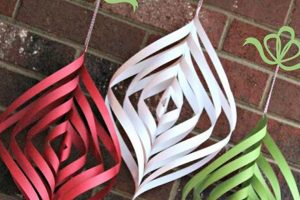The creation of miniature edible dwellings adorned with personalized embellishments represents a seasonal tradition enjoyed by individuals of all ages. These handcrafted displays involve constructing a small house from gingerbread and decorating it with a variety of candies, icing, and other edible items. For instance, one might utilize colorful gumdrops as roof tiles or pretzel sticks to create a picket fence.
Engaging in the practice offers multiple advantages. It fosters creativity and allows for personalized expression. Furthermore, the activity provides an opportunity for families and friends to bond through a shared project. Historically, the custom can be traced back to 19th-century Germany, becoming associated with the Christmas holiday season.
The following will explore specific techniques and materials useful in crafting impressive confectionery architectural displays. Detail on icing recipes, candy selection, and structural integrity is elaborated in the following sections. Further, considerations for longevity and optimal display techniques will be reviewed.
Essential Tips for Confectionery Construction
Achieving structurally sound and aesthetically pleasing edible architecture requires careful planning and execution. The following tips provide guidance for optimal results.
Tip 1: Foundation Stability: Ensure a level and sturdy base for the structure. A warped or uneven surface will compromise the overall integrity of the house, potentially leading to collapse. A solid piece of cardboard or a wooden board serves as a suitable foundation.
Tip 2: Icing Consistency: Royal icing serves as the primary adhesive. Achieve a balance between thickness and spreadability. Icing that is too thin will not hold effectively, while icing that is too thick will be difficult to pipe and manipulate.
Tip 3: Structural Reinforcement: Allow the icing to dry completely between each stage of construction. This provides necessary strength. Using toothpicks or skewers to temporarily brace walls during the drying process is advisable, removing them once the icing has fully hardened.
Tip 4: Candy Selection: Consider the weight and adherence properties of decorative candies. Heavier candies may require more icing or additional support. Smaller, flatter candies often adhere more readily.
Tip 5: Pre-Planning Design: Sketch out the desired design beforehand. This allows for accurate cutting of gingerbread pieces and ensures a cohesive overall aesthetic. Templates can be created from paper or cardboard.
Tip 6: Controlled Application: Employ piping bags for precise application of icing. This allows for controlled lines and consistent coverage, especially when creating intricate details.
Tip 7: Humidity Control: Excessive humidity can soften gingerbread and impede icing drying. Construct the house in a cool, dry environment to maximize structural stability and decoration adherence.
Effective implementation of these techniques will result in a durable and visually appealing confectionery creation, suitable for seasonal display or edible enjoyment. Prioritizing stability and design elements is crucial for a successful outcome.
The subsequent section will delve into specific design themes and advanced decorating methods to elevate the craft of edible architectural construction.
1. Icing Consistency
Icing consistency is a foundational element in constructing and decorating edible gingerbread structures. The adhesive properties and structural support provided by icing are directly dependent on achieving the appropriate texture and viscosity. Improper consistency can compromise the stability and aesthetic appeal of the finished creation.
- Royal Icing for Structural Support
Royal icing, composed of powdered sugar, meringue powder, and water, is typically employed for adhering gingerbread pieces. A thick consistency is required to create strong bonds between walls, roofs, and other structural components. Insufficient thickness results in weak joints prone to collapse under the weight of the gingerbread or applied candies. For example, a very thick icing is crucial to build walls and keep in place, so the entire structure is not in danger.
- Piping Icing for Decorative Detail
For intricate details and decorative elements, a thinner, more pliable icing is essential. This allows for smooth lines, delicate patterns, and precise application. Icing that is too thick will be difficult to pipe, resulting in uneven lines and a lack of definition. Conversely, excessively thin icing will spread uncontrollably, obscuring details. A medium icing thickness is required for pipping details such as door outline.
- Run-Out Icing for Flooding
Flooding involves filling in large areas with a smooth, even layer of icing. This technique necessitates a very fluid consistency that spreads easily and self-levels. Achieving the correct consistency prevents air bubbles and ensures a uniform surface. Incorrect “run-out” icing may damage the design when the gingerbread is created. This icing is often used for roof coating or even wall coating to fill the design.
- Impact of Humidity and Temperature
Environmental factors such as humidity and temperature can significantly influence icing consistency. High humidity can cause icing to become sticky and difficult to work with, while warm temperatures can lead to premature drying. Adjusting the liquid content of the icing recipe may be necessary to compensate for these variations. Careful attention to environmental conditions is paramount for consistent results during the confectionary process.
Therefore, mastering icing consistency is crucial for the successful creation of impressive gingerbread constructions. The choice of icing consistency determines the decorations’ capacity to adhere appropriately to the gingerbread. Tailoring the recipe to the intended application and accounting for environmental conditions is essential for achieving both structural integrity and aesthetic refinement.
2. Candy Selection
Candy selection represents a pivotal aspect of edible architectural construction, directly influencing both the visual appeal and structural integrity of the final product. The chosen confections contribute to the aesthetic theme, provide varied textures, and, in some instances, offer structural reinforcement. Thoughtful consideration of candy characteristics is essential for optimal results.
- Structural Candies: Load-Bearing Elements
Certain candies possess inherent shapes and consistencies suitable for load-bearing roles. Hard candies, such as peppermints or gumdrops, can be arranged to form stable walls or rooftops. Their rigidity allows them to withstand external pressure and maintain the structure’s form. For instance, rows of peppermints, secured with icing, can create a durable and visually appealing roofline. These structural elements reduce the risk of collapse, particularly in larger or more complex designs.
- Decorative Candies: Enhancing Aesthetic Appeal
A wide array of candies serves primarily to enhance the aesthetic presentation of the edible dwelling. Sprinkles, sugar pearls, and nonpareils contribute color and texture to surfaces. Small, colorful candies, such as M&Ms or jelly beans, can be arranged to create patterns or represent architectural details like windows or doors. The strategic placement of these decorative elements elevates the visual impact and fosters a sense of artistry.
- Adhesive Considerations: Candy Compatibility
The adhesive properties of icing must be considered in relation to the selected candies. Smooth, non-porous candies, such as chocolate or hard candies, may require a thicker icing or a longer drying time to ensure secure adhesion. Conversely, porous candies, like marshmallows, readily bond with icing and may require less adhesive. Understanding these interactions prevents dislodgement and maintains the integrity of the decorations.
- Thematic Integration: Candy Representation
Candy selection can reinforce the overall design theme of the confectionery creation. For a winter wonderland motif, white candies like sugar cubes or snowflake sprinkles can evoke a snowy landscape. A gingerbread house intended to represent a forest dwelling might incorporate green candies, pretzel sticks for logs, and gumdrops as foliage. The careful integration of candies that align with the chosen theme enhances the narrative and visual consistency of the design.
In conclusion, strategic candy selection is integral to the success of architectural creation. Choices regarding structural support, aesthetic enhancement, adhesive compatibility, and thematic integration collectively determine the visual impact and longevity of the edible structure. This process, therefore, needs careful attention and detailed planning.
3. Structural Integrity
Structural integrity represents a critical consideration in the realm of confectionery architecture. The ability of a gingerbread house to maintain its shape and withstand external forces, such as gravity and handling, directly impacts its aesthetic appeal and longevity. A structurally sound house provides a stable canvas for decorations, ensuring that embellishments remain securely affixed and the overall design is preserved.
- Gingerbread Dough Composition and Baking
The composition of the gingerbread dough and the baking process significantly influence structural strength. A dough recipe that incorporates the appropriate ratio of flour to binding agents, such as molasses or honey, is essential. Overmixing or undermixing the dough can result in weakness, as can overbaking or underbaking. Properly baked gingerbread should be firm and slightly crisp, providing a solid foundation for construction. For instance, gingerbread must be firm after baking to allow a stable build.
- Icing as an Adhesive and Reinforcement
Royal icing serves as the primary adhesive, bonding the gingerbread pieces together. Its consistency and application technique are crucial for structural integrity. A thick, consistent icing provides the strongest bond, filling gaps and creating a solid connection between surfaces. Applying icing along all edges and ensuring complete coverage maximizes its adhesive properties. Allowing sufficient drying time before adding further decorations is also important to enhance stability.
- Design and Geometry of the Structure
The design and geometry of the gingerbread house itself play a significant role in its structural performance. Simple, symmetrical designs with stable bases are inherently more robust than complex, asymmetrical structures. Internal supports, such as gingerbread columns or strategically placed candies, can provide additional reinforcement. Furthermore, the angle and orientation of roof pieces influence their ability to withstand weight and pressure.
- Environmental Factors: Humidity and Temperature
Environmental conditions, particularly humidity and temperature, can impact the structural integrity of a gingerbread house. Excessive humidity can soften the gingerbread and weaken the icing, potentially leading to collapse. High temperatures can cause the icing to melt or deform, compromising its adhesive properties. Maintaining a cool, dry environment is essential for preserving the structure’s integrity. Considerations must be made to provide an appropriate environment for design preservation.
In conclusion, maintaining structural integrity in confectionery creations requires careful attention to dough composition, baking technique, icing application, structural design, and environmental control. These factors collectively determine the durability and longevity of the decorated edible structure. Therefore, prioritizing structural integrity is key for a successful creative building endeavor.
4. Color Palette
In the context of constructing and embellishing edible gingerbread structures, the color palette assumes a role of considerable influence. It dictates the aesthetic harmony and thematic consistency of the finished product. The strategic selection and arrangement of colors, achieved through various candies and icing, serve to evoke specific moods, reinforce design themes, and enhance visual appeal. A poorly chosen palette can detract from the overall impact, while a well-considered one elevates the confectionery construction to an art form. For instance, a limited palette of whites, silvers, and pale blues reinforces a winter aesthetic. In comparison, a house decorated with vibrant reds, greens, and yellows might convey a sense of festive cheer. The choice reflects the desired impact of the designer.
The practical application of color theory is relevant in this domain. Monochromatic schemes, utilizing varying shades of a single color, can create a sophisticated and unified look. Complementary color pairings, such as red and green or blue and orange, provide visual contrast and energy. Analogous color schemes, employing colors adjacent to each other on the color wheel, offer a harmonious and balanced effect. The successful implementation of these principles requires careful planning and experimentation, as the color of the base gingerbread also needs considering, and often influences what other colors work in concert.
The selection of a fitting color palette is key for an esthetic project. The specific hues will support the theme and visual appeal. The strategic integration of candies and icing in a controlled manner facilitates designs’ final touches. By controlling color selection and icing consistency, the process creates lasting artistic creations.
5. Design Theme
The design theme provides a framework for aesthetic choices in constructing and decorating gingerbread houses. It establishes a cohesive vision that guides the selection of colors, candies, and architectural details, transforming a simple edible structure into a thematic representation.
- Thematic Cohesion
A clearly defined design theme ensures that all elements of the gingerbread house contribute to a unified visual narrative. For example, a “winter wonderland” theme necessitates the use of white icing, silver dragees, and snowflake-shaped candies to evoke a snowy landscape. A theme that lacks cohesion may result in a visually disjointed and less impactful creation.
- Architectural Style Integration
The design theme may incorporate specific architectural styles, influencing the shape and structure of the gingerbread house. A Victorian theme could include intricate gingerbread detailing, steeply pitched roofs, and delicate icing patterns, while a modern theme may feature clean lines, minimalist decorations, and geometric shapes. Integrating these elements adds depth and authenticity to the design.
- Seasonal and Holiday Representation
Design themes often reflect seasonal or holiday traditions, aligning the gingerbread house with specific festive occasions. A Christmas theme might incorporate gingerbread men, candy canes, and miniature Christmas trees, while a Halloween theme could feature ghosts, pumpkins, and spooky architectural details. This thematic alignment enhances the celebratory nature of the confectionary creation.
- Personal Narrative and Creativity
The design theme offers an avenue for personal expression and creative storytelling. A gingerbread house could represent a favorite book, movie, or travel destination, incorporating elements that reflect the chosen narrative. This personalization transforms the edible structure into a unique and meaningful piece of art.
In summary, the design theme provides essential direction for creating a visually appealing and conceptually unified gingerbread house. It establishes a framework for integrating architectural styles, seasonal elements, and personal narratives, transforming a simple edible structure into a thematic representation that has artistic meaning and purpose.
6. Edible Adhesives
The structural integrity and aesthetic success of architectural creations are intrinsically linked to the effective use of edible adhesives. These substances, primarily various forms of icing, serve as the binding agent that holds gingerbread pieces together and secures decorative elements. The choice of adhesive and its method of application directly influence the stability and visual appeal of the finished product. For example, insufficient adhesive leads to structural weaknesses, while an excess can obscure intricate details and detract from the overall aesthetic.
Royal icing, a mixture of powdered sugar, meringue powder, and water, is a primary example. Its capacity to harden significantly upon drying renders it suitable for constructing the foundational framework of the gingerbread house. The consistency of the royal icing must be carefully controlled. For structural adhesion, a thicker consistency is required, while a thinner consistency is appropriate for finer decorative work, such as piping delicate patterns or securing small candies. Alternatives include melted chocolate, which offers a different flavor profile and can be particularly effective for attaching heavier elements. However, its lower melting point compared to royal icing requires a cooler ambient temperature to prevent softening and structural instability. The consistency of the ‘glue’ is significant for longevity of design. Incorrect adhesion practices can influence the decay of the design.
In conclusion, edible adhesives represent an indispensable component in architectural construction. Their proper selection and application are paramount for achieving both structural stability and aesthetic refinement. While royal icing remains the most widely used and versatile adhesive, alternative options exist to suit specific design requirements and flavor preferences. The challenges lie in mastering the consistency and application techniques to ensure long-lasting and visually pleasing confectionery creations.
Frequently Asked Questions About DIY Gingerbread House Decorations
This section addresses common inquiries regarding the construction and adornment of edible gingerbread dwellings, providing concise and informative answers to enhance the creation process.
Question 1: What is the optimal consistency for royal icing used in securing gingerbread house walls?
The ideal consistency for royal icing intended to adhere gingerbread walls is thick, similar to toothpaste. This ensures a strong bond capable of supporting the weight of the structure. Thin icing will compromise stability.
Question 2: How can one prevent a gingerbread house from collapsing during the construction process?
Several factors contribute to structural stability. Ensure a level foundation, use thick royal icing, allow each layer of icing to dry completely before proceeding, and consider temporary supports like toothpicks during the drying process.
Question 3: What types of candies are best suited for decorating gingerbread houses?
A wide variety of candies can be employed. Hard candies like peppermints can form structural elements, while smaller candies such as sprinkles or nonpareils provide decorative details. Consider candy weight and adherence properties when selecting.
Question 4: How does humidity affect the construction and decoration of gingerbread houses?
High humidity can soften gingerbread and impede icing drying, compromising structural integrity. Constructing the house in a cool, dry environment is recommended to maximize stability and decoration adherence.
Question 5: Is it necessary to use a template when cutting out gingerbread pieces?
While not strictly necessary, using a template is highly recommended. Templates ensure accurate cutting and consistent sizing of gingerbread pieces, resulting in a more uniform and structurally sound house.
Question 6: What are some alternative edible adhesives besides royal icing?
While royal icing is the most common adhesive, melted chocolate can also be used, particularly for attaching heavier decorations. However, its lower melting point requires a cooler environment.
Careful planning and execution, combined with an understanding of material properties and environmental factors, are essential for successfully constructing and decorating gingerbread houses.
The next section will explore advanced techniques and considerations for creating truly exceptional and memorable confectionery creations.
Conclusion
This exposition has detailed various elements integral to constructing and decorating confectionery domiciles. Key considerations included icing consistency, candy selection, structural integrity, color palette, design theme, and edible adhesives. The application of these principles determines the success of a structurally sound and aesthetically pleasing edible architectural display.
Mastery of these techniques yields the capacity to produce creative and impactful displays. Continued exploration and refinement of these processes will further elevate the art of confectionery construction, ensuring that the tradition remains a source of creative expression and seasonal enjoyment. Skill in this area improves the craftsmanship of future holiday seasons and provides a lasting artistic creation.







